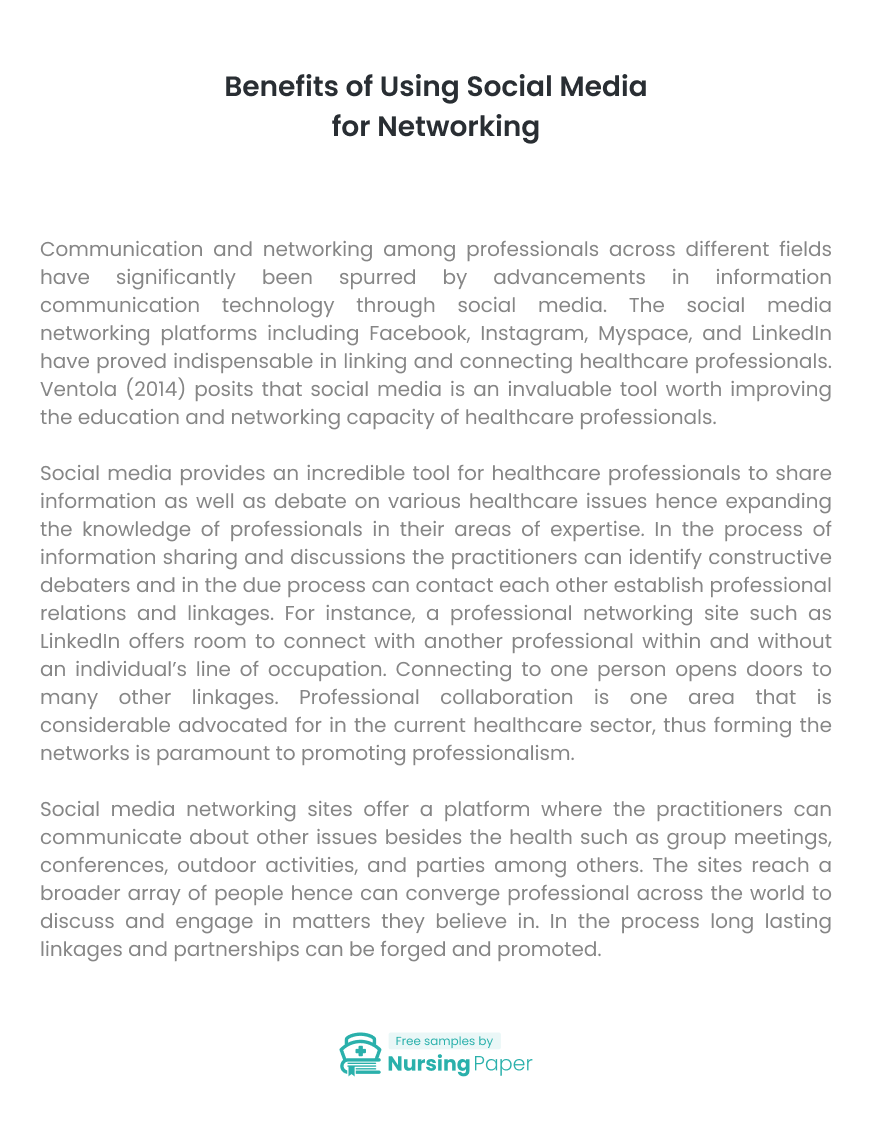
Benefits of Using Social Media for Networking
Introduction
Communication and networking among professionals across different fields have significantly been spurred by advancements in information communication technology through social media. The social media networking platforms including Facebook, Instagram, Myspace, and LinkedIn have proved indispensable in linking and connecting healthcare professionals. Ventola (2014) posits that social media is an invaluable tool worth improving the education and networking capacity of healthcare professionals.
Social media provides an incredible tool for healthcare professionals to share information as well as debate on various healthcare issues hence expanding the knowledge of professionals in their areas of expertise. In the process of information sharing and discussions the practitioners can identify constructive debaters and in the due process can contact each other establish professional relations and linkages. For instance, a professional networking site such as LinkedIn offers room to connect with another professional within and without an individual’s line of occupation. Connecting to one person opens doors to many other linkages. Professional collaboration is one area that is considerable advocated for in the current healthcare sector, thus forming the networks is paramount to promoting professionalism.


Social media networking sites offer a platform where the practitioners can communicate about other issues besides the health such as group meetings, conferences, outdoor activities, and parties among others. The sites reach a broader array of people hence can converge professional across the world to discuss and engage in matters they believe in. In the process long lasting linkages and partnerships can be forged and promoted. An individual with a strong network base is in a position to quickly develop based on the heterogeneity of people, as one partner can expose them to one factor what is complement or supplement to the other from a different network.
Ventola (2014) surveyed social media application by healthcare professionals. The survey vindicated over a third of practitioners have active social media users, where over 90% of the practitioners use the sites for personal activities while 65% for professional purposes. Some of the professional networking sites are restrictive to only constitute of physicians such Sermo and Doximity in the United States among others such as the Doctor’s Hangout, QuantiaMD, and Doc2Doc for doctors; PharmaQD, ASHP Connect and the Pharmacists Society for pharmacists; and Social RN, and NursingLink for nurses. Other include YouTube channels, Facebook fan pages, Instagram sites and LinkedIn (Ventola, 2014). These sites enable the practitioners to engage in online communities, create linkages, consult experts and communicate with each other on a myriad of issues.
For instance, Breathe California Sacramento Region has a Facebook fan page where they have shared information on clean air and prevention of related respiratory diseases. They advocate for salient public policies on air pollution, research and public education on the same alongside partnering with the youth and other professionals. They take part in several bonding and educational activities offering a platform for both healthcare professionals and the general public to interact. They also have outdoor activities and discussion where the members share and debate on issues of which provides an avenue for forging networks and communications. The members share their biodata such Paul Adams and Carol Gauer Johnson who took part in Breather Bike Trek and work with Breath Califonia, through their engagement and urge to other to join them they are bound to expand their network base (Breathe California Sacramento Region, 2018).

1. Breathe California Sacramento Region. (2018). Breathe California Sacramento Region Facebook Fan Page. Retrieved April 11, 2018, from Facebook: https://web.facebook.com/sacbreathe/
2. Ventola, C. L. (2014). Social Media and Health Care Professionals: Benefits, Risks, and Best Practices. Pharmacy and Therapeutics, 39(7), 491.



The download will start shortly.

The download will start shortly.
 Subject:
Medicine
Subject:
Medicine  Number of pages: 10
Number of pages: 10  Subject:
Nursing
Subject:
Nursing  Number of pages: 5
Number of pages: 5  Subject:
Health and Social Care
Subject:
Health and Social Care  Number of pages: 2
Number of pages: 2  Subject:
Nursing
Subject:
Nursing  Number of pages: 10
Number of pages: 10  Subject:
Nursing
Subject:
Nursing  Number of pages: 3
Number of pages: 3  Subject:
Nursing
Subject:
Nursing  Number of pages: 5
Number of pages: 5  Subject:
Health and Social Care
Subject:
Health and Social Care  Number of pages: 3
Number of pages: 3  Subject:
Nursing
Subject:
Nursing  Number of pages: 2
Number of pages: 2  Subject:
Health and Social Care
Subject:
Health and Social Care  Number of pages: 3
Number of pages: 3  Subject:
Medicine
Subject:
Medicine  Number of pages: 3
Number of pages: 3  Subject:
Nursing
Subject:
Nursing  Number of pages: 2
Number of pages: 2  Subject:
Medicine
Subject:
Medicine  Number of pages: 3
Number of pages: 3  Subject:
Nursing
Subject:
Nursing  Number of pages: 3
Number of pages: 3  Subject:
Health and Social Care
Subject:
Health and Social Care  Number of pages: 10
Number of pages: 10  Subject:
Health and Social Care
Subject:
Health and Social Care  Number of pages: 6
Number of pages: 6 
